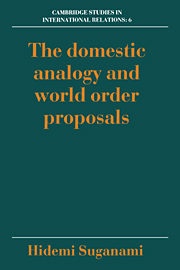Book contents
- Frontmatter
- Contents
- Acknowledgements
- Introduction
- 1 The domestic analogy debate: a preliminary outline
- 2 The range and types of the domestic analogy
- 3 Some nineteenth-century examples
- 4 Contending doctrines of the Hague Peace Conferences period
- 5 The impact of the Great War
- 6 The effect of the failure of the League on attitudes towards the domestic analogy
- 7 The domestic analogy in the establishment of the United Nations
- 8 The domestic analogy in contemporary international thought
- 9 The domestic analogy and world order proposals: typology and appraisal
- Conclusion
- Notes
- References
- Index of personal names
- Subject index
9 - The domestic analogy and world order proposals: typology and appraisal
Published online by Cambridge University Press: 18 December 2009
- Frontmatter
- Contents
- Acknowledgements
- Introduction
- 1 The domestic analogy debate: a preliminary outline
- 2 The range and types of the domestic analogy
- 3 Some nineteenth-century examples
- 4 Contending doctrines of the Hague Peace Conferences period
- 5 The impact of the Great War
- 6 The effect of the failure of the League on attitudes towards the domestic analogy
- 7 The domestic analogy in the establishment of the United Nations
- 8 The domestic analogy in contemporary international thought
- 9 The domestic analogy and world order proposals: typology and appraisal
- Conclusion
- Notes
- References
- Index of personal names
- Subject index
Summary
A comparative analysis of a wide variety of ideas about world order which have emerged since the early part of the nineteenth century reveals that they are clustered around five basic positions. First, there is the legal school, advocating the internationalist, as opposed to the cosmopolitanist, form of domestic analogy. Second is the diplomatic school, critical of the ways in which and the extent to which the domestic analogy is employed by the legal school.
Both the legal and diplomatic schools support the idea that the sovereign states system should remain intact. They are concerned primarily with the problem of creating order in the external relations of sovereign states. And they both accept the principle that the official intercourse between states be conducted by diplomats, who act under instruction from the executive branches of their respective governments. The difference between the two schools is that while the legal school argues in favour of the legalistic use of the domestic analogy, the diplomatic school is opposed to it. The legal school advances the idea of ‘peace through law’ and, in its fullest form, advocates the creation of an international organization equipped with judicial, legislative and executive bodies for the management of international relations. By contrast, the diplomatic school prescribes the maintenance of international order through the operation of those practices, such as diplomacy, war and neutrality, which are claimed to be indigenous institutions of international society.
- Type
- Chapter
- Information
- The Domestic Analogy and World Order Proposals , pp. 165 - 196Publisher: Cambridge University PressPrint publication year: 1989

